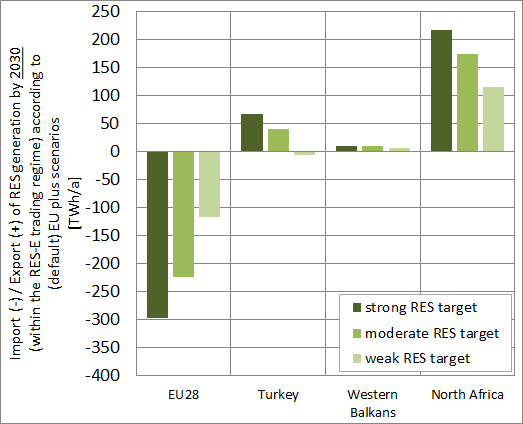
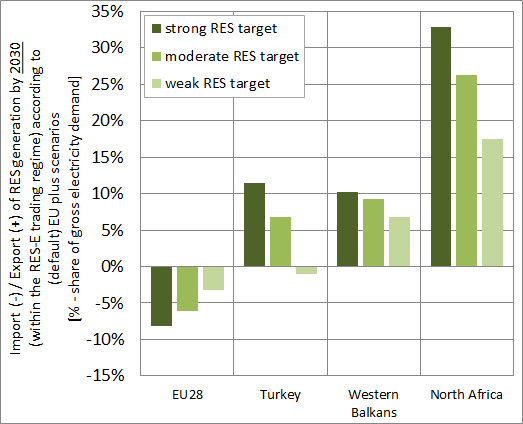
The following figures elaborate on how different levels of RES generation could be exchanged by 2030 and beyond, limited to key scenarios of full RES cooperation across the enlarged geographical region and dependent on whether the EU implements strong or moderate targets for RES generation. Note that all this builds on the assumption that a joint market is established for RES in the electricity sector, allowing full RES cooperation across the EU and its neighbouring countries (Turkey, Western Balkans and North Africa) in the period post 2020.
Focus on 2030: As can be seen in Figure 4-3, depicted on the left side of the chart, the amount imported by the EU in 2030 depends strongly on whether a strong, moderate or weak target for RES deployment is set. In Turkey, a weak RES target would even imply importing RES as opposed to exporting it in a strong or moderate RES target framework. Expressed in absolute terms, the EU would import 296 TWh in 2030 under a strong RES target according to EU plus (full RES cooperation) scenarios. A moderate target would then lead to imports of 224 TWh, whereas under a weak target merely 117 TWh would be needed as Third country imports for target fulfilment. Turkey would (virtually) export 67.9 TWh under a strong target, whereas it would (virtually) import 5.7 TWh in a weak target scenario. The Western Balkan states exhibit less distinct scenarios. A strong target leads to the virtual export of 10.7 TWh whereas the countries remain exporters, of a total amount of 7.7 TWh under a weak target. A strong target leads North Africa to in that case physically export quite a substantial amount of RES: 216 TWh as com-pared to merely 115 TWh when a weak RES target is assumed.
The right hand side of Figure 4-3 shows the share of these exports in the gross electricity demand of the respective countries and regions. Again, the three EU plus cases are shown, assuming a strong, moderate and weak target for RES deployment in the EU and the Energy Community. In relative terms, as can be seen on the right hand side of this graph, this would mean that the EU28 Member States import, partly virtually (from Turkey and Western Balkans) and partly physically, RES at a volume that equals 3.2% to 8.1% of the EU28’s gross electricity demand in 2030. Turkey could be a net importer in a weak RES target scenario, where imports correspond to 1% of its 2030 gross electricity demand, whereas (virtual) exports could amount up to almost 11.4% (of gross electricity demand) by 2030 assuming a strong RES target. The Western Balkan region is predicted to be a net exporter in all scenarios. Concretely, these exports would range between 6.8 and 10.3% of the regions gross electricity demand. For North Africa, the potential RES-E share for physical export in 2030 lies between 17.5 and 32.8% depending on the respective target for RES deployment.


Figure 4-3: Exchange of RES volumes between regions by 2030 in absolute terms (TWh) according to EU plus (full cooperation) scenarios following a strong, moderate or weak RES target (left) and in relative terms (right)
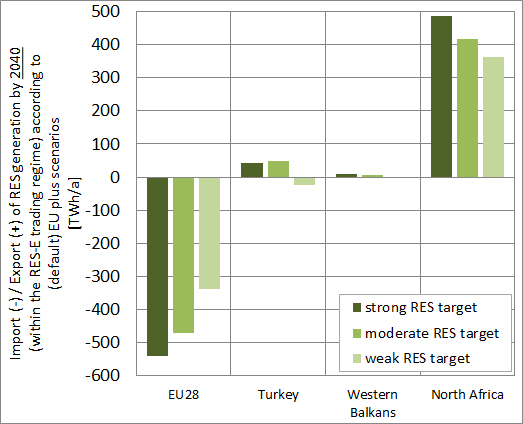
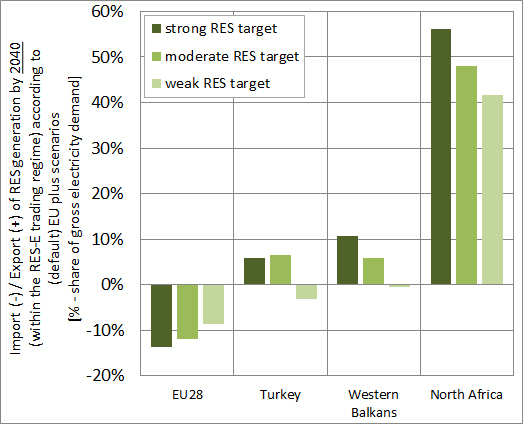
Figure 4-4: Exchange of RES volumes between regions by 2040 in absolute terms (TWh) according to EU plus (full cooperation) scenarios following a strong, moderate or weak RES target (left) and in relative terms (right)
Focus on 2040: Figure 4-4 displays the exchange of RES volumes by 2040 in absolute and relative terms for the EU plus (full cooperation) scenario. One can observe that in comparison to the 2030 mid-term perspective, imports to the EU 28 member states increase substantially. Specifically, assuming a strong target, the EU 28 member states would import 538 TWh by 2040, 469 TWh with a moderate target and 336 TWh if a weak target for RES deployment is assumed at EU level. In relative terms, as can be seen on the right hand side of Figure 42, this amounts to a range of 13.6% (strong target) to 8.5% (weak target) of EU’s gross electricity demand in 2040.
In Turkey, a strong and moderate target would lead to roughly the same exports of RES that amount to 47 or 43 TWh respectively. A weak overall RES target would make Turkey a net importer even in the long term perspective up to 2040 (22 TWh of RES imports in 2040). In relative terms these scenarios make up a bandwidth of 5.9% (strong), 6.4% (moderate) or -3.1% (weak target). For the Western Balkans, the long-term (2040) perspective is as follows: a weak overall target would lead to net imports of 0.5 TWh of RES by 2040, or 0.5% of gross electricity demand. A moderate target changes the flow of RES and makes the Western Balkans an exporting region. Under this specific target the Western Balkan region would export 5.9% of its gross electricity demand which amounts to a number of 5.9 TWh in 2040. Increasing the target for RES even further would increase exports by 5.2 percentage points up to a value of 10.7 TWh. North Africa, in the long- as well as in the mid-term is a clear RES exporting region, independent of the respective target set at EU-level. Assuming a strong target for RES at EU level, North Africa would export 485 TWh in 2040, 56% of its gross domestic electricity demand. A moderate target leads to an export of 415 TWh or 48%, and a weak target to 360.7 TWh or 41.7% of gross domestic electricity demand, respectively.
Prospects for RES cooperation by assessed region: Complementary to above, below we illustrate the prospects for renewable electricity exchange by region according to all assessed RES cooperation cases.
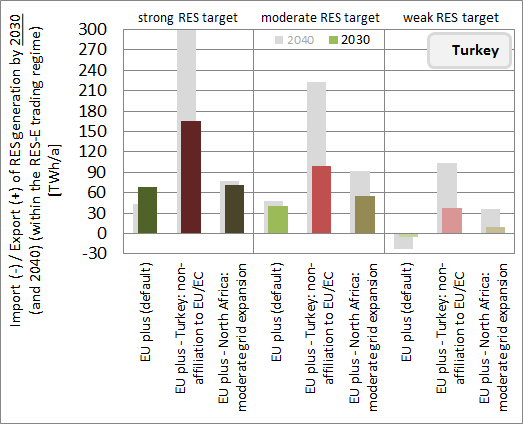
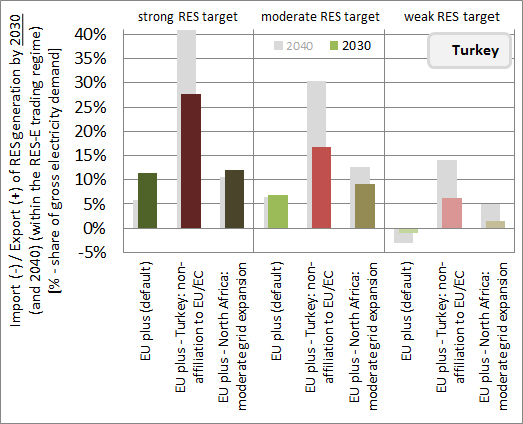
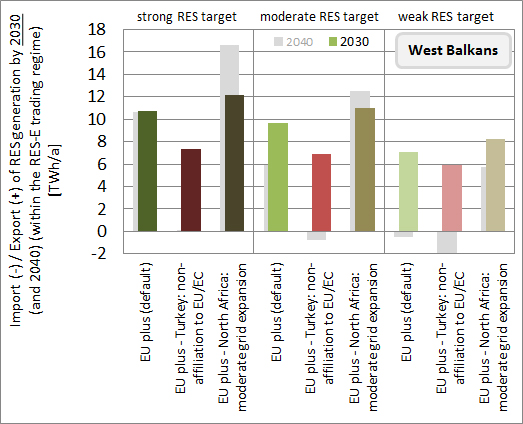
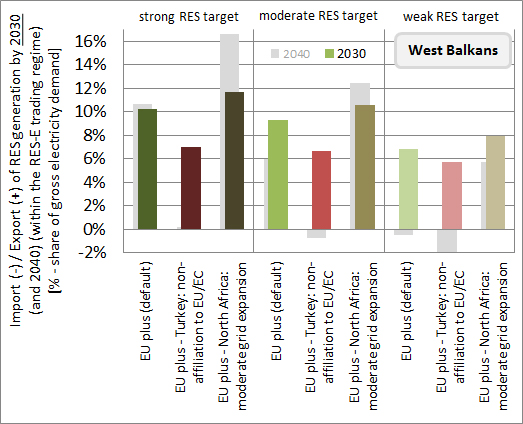
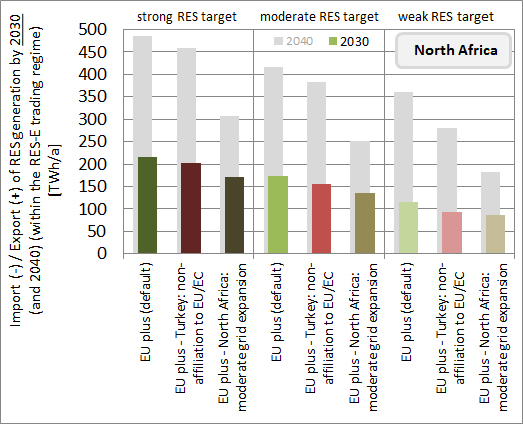
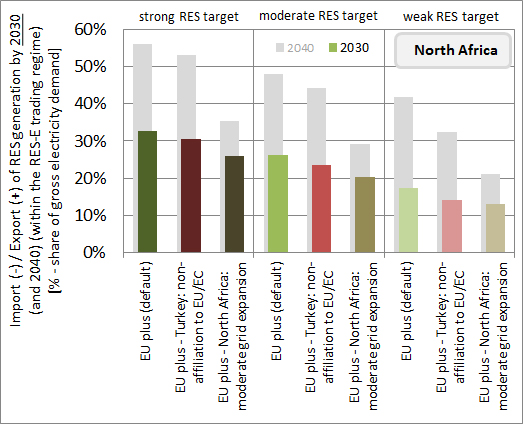
| <<Back | >>Back to Introduction<< | Next>> |